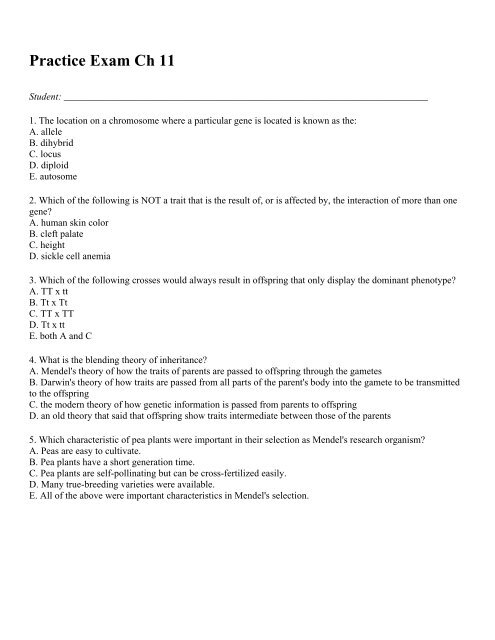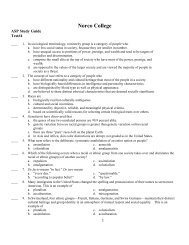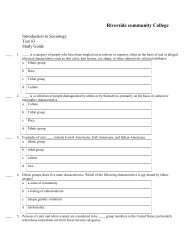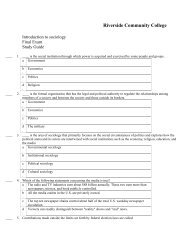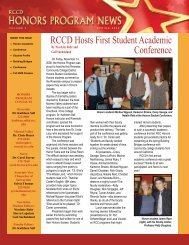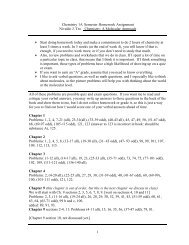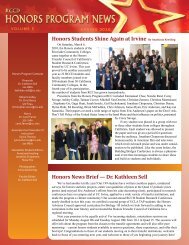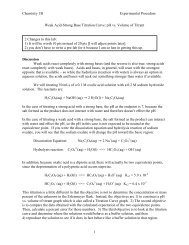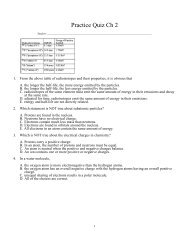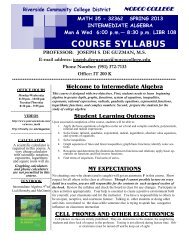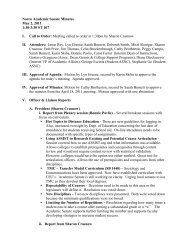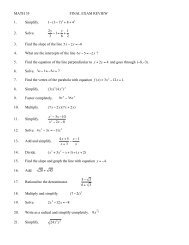Practice Exam Ch 11
Practice Exam Ch 11
Practice Exam Ch 11
- No tags were found...
You also want an ePaper? Increase the reach of your titles
YUMPU automatically turns print PDFs into web optimized ePapers that Google loves.
13. The pedigree chart depicts the inheritance pattern of ____. Circles depict females and squares to depictmales. Colored shape represent affected individuals (expressing a trait) and uncolored shapes are unaffected (donot express a trait).A. an autosomal recessive characteristic with both parents being heterozygousB. an autosomal dominant characteristic with both parents being homozygous dominantC. an autosomal recessive characteristic with both parents being homozygous recessiveD. none of the above14. A range of genotypes and phenotypes occur in polygenic inheritance. Draw a graph that depicts this patternof continuous variation in polygenic inheritance.15. Where does independent assortment occur in meiosis (what stage)? Where is the law of segregation evidentin meiosis? What is the result of independent assortment and segregation? Explain your answer.16. If the parents are AO and BO genotypes for the ABO blood group, their children could include which of thefollowing genotypes?A. AO and BO onlyB. AO, BO, and AB onlyC. AA, BB, and AB onlyD. AO, BO, and OO onlyE. AO, BO, AB, and OO only17. Since each child of two heterozygous parents has a 1/2 chance of receiving a recessive trait from eachparent,A. if the first child is phenotypically recessive, then the next child must be phenotypically dominant.B. if the first child is phenotypically recessive, then the next child has a 3/4 chance of being phenotypicallyrecessive.C. if the first child is phenotypically recessive, then the next child has a 1/2 chance of being phenotypicallyrecessive.D. no matter what the first child's phenotype, the next child will have a 1/4 chance of being phenotypicallyrecessive.
18. If the probability of event A is 3/4 and the probability of event B is 1/4, then the probability of both A and Boccurring at the same time isA. 3/4.B. 1/4.C. 1 or absolute certainty.D. 1/2.E. 3/16.19. In what kind of classic Mendelian cross would you expect to find a ratio of 9:3:3:1 among the F 2 offspring?A. monohybrid crossB. dihybrid crossC. testcrossD. None of the choices is correct.20. If a woman is a carrier for the color-blind recessive allele and her husband is normal, what are their chancesthat a son will be color-blind?A. None since the father is normal.B. 50% since the mother is the only carrier.C. 100% because the mother has the gene.D. 25% because the mother is a hybrid.E. None since he will also be just a carrier.21. A testcross involves an individual exhibiting the dominant phenotype but an unknown genotype beingcrossed with an individual that has a(n) ___________ genotype.A. homozygous dominantB. heterozygous dominantC. homozygous recessiveD. any of the choices22. If individuals exhibiting a dominant phenotype are crossed and produce only offspring with the dominantphenotype, what would be the logical genotype of the parents?A. both are homozygous recessiveB. one is heterozygous and one is homozygous dominantC. both are homozygous dominantD. both are heterozygousE. both B and C23. If a human who is a tongue roller (T) and has unattached ear lobes (E) marries a person who cannot rolltheir tongue and has attached earlobes, could they produce an offspring that was also a non-tongue roller withattached earlobes? What would be the genotype of the first parent? the second parent?A. yes; TtEe; tteeB. yes; TtEE; ttEeC. no; TTEE; tteeD. unable to determine from the information given
24. As many as 60 % of people in malaria-infected regions of Africa have the sickle-cell allele, but only about10% of the U.S. population of African ancestry carries the allele. Malaria remains a major disease in centralAfrica but has not been a serious problem in the U.S. for many generations. What is/are the reason(s) for thedifference in the percentages and what is a reasonable statement about future percentages?A. The presence of malaria in Africa maintains the advantage of the heterozygous sickle-cell trait, and theprevalence of malaria will likely continue to preserve the 60% rate.B. The U. S. percentage may have always been somewhat lower due to immigration from nonmalaria regions,but changes in sites and rates of immigration could occur.C. Lack of widespread malaria in the United States would have made both homozygous and heterozygouscarriers of sickle-cell undergo several generations of negative selection, and we should expect this to continueunless innovative therapies give all individuals an equal chance of surviving and reproducing.D. All of the choices are reasonable.25. An individual with blood type A marries an individual with blood type B.A. What blood types could their offspring exhibit?B. Provide the possible genotypes of parents and offspring produced.C. What pattern of inheritance is this?26. Which is associated with the inability to produce factor VIII in the blood?A. Williams syndromeB. trisomy 21C. color-blindnessD. Hemophilia AE. Duchenne muscular dystrophy27. Cystic fibrosis and Niemann-Pick Disease are common autosomal dominant disorders.True False28. Each gamete carries one factor, now called an allele, for each inherited trait.True False29. In a case of incomplete dominance, the phenotypic ratio of the F 2 generation is the same as the genotypicratio.True False30. What is the blending theory of inheritance? How did Mendel disprove this theory?


